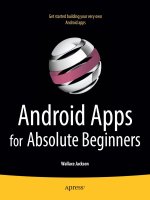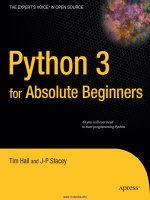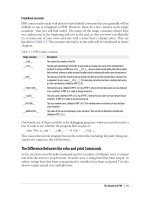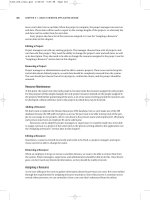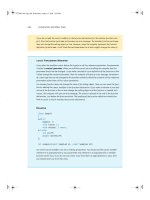PHP for Absolute Beginners PHẦN 8 pdf
Bạn đang xem bản rút gọn của tài liệu. Xem và tải ngay bản đầy đủ của tài liệu tại đây (1.25 MB, 41 trang )
CHAPTER 9 SYNDICATING THE BLOG
268
// Remove the fulldisp flag
array_pop($e);
// Perform basic data sanitization
$e = sanitizeData($e);
// Add a content type header to ensure proper execution
header('Content-Type: application/rss+xml');
// Output the XML declaration
echo "<?xml version=\"1.0\" encoding=\"UTF-8\"?>\n";
?>
<rss version="2.0">
<channel>
<title>My Simple Blog</title>
<link>http://localhost/simple_blog/</link>
<description>This blog is awesome.</description>
<language>en-us</language>
</channel>
</rss>
At this point, you have an array that contains your entries ready for output. You use a foreach
loop to display each entry.
Begin by generating an item with a title, a description, and a link. The only extra step is to
escape all HTML entities in your description—you need to convert special characters to their HTML
entity equivalents, such as < to <. This is necessary because unescaped HTML will cause an error for
RSS readers. You accomplish this by calling htmlentities() on the contents of the entry column.
Add the following code in bold to rss.php:
<?php
// Include necessary files
include_once ' /inc/functions.inc.php';
include_once ' /inc/db.inc.php';
// Open a database connection
$db = new PDO(DB_INFO, DB_USER, DB_PASS);
// Load all blog entries
$e = retrieveEntries($db, 'blog');
Download at WoweBook.Com
CHAPTER 9 SYNDICATING THE BLOG
269
// Remove the fulldisp flag
array_pop($e);
// Perform basic data sanitization
$e = sanitizeData($e);
// Add a content type header to ensure proper execution
header('Content-Type: application/rss+xml');
// Output the XML declaration
echo "<?xml version=\"1.0\" encoding=\"UTF-8\"?>\n";
?>
<rss version="2.0">
<channel>
<title>My Simple Blog</title>
<link>http://localhost/simple_blog/</link>
<description>This blog is awesome.</description>
<language>en-us</language>
<?php
// Loop through the entries and generate RSS items
foreach($e as $e):
// Escape HTML to avoid errors
$entry = htmlentities($e['entry']);
// Build the full URL to the entry
$url = 'http://localhost/simple_blog/blog/' . $e['url'];
?>
<item>
<title><?php echo $e['title']; ?></title>
<description><?php echo $entry; ?></description>
<link><?php echo $url; ?></link>
</item>
<?php endforeach; ?>
</channel>
</rss>
Download at WoweBook.Com
CHAPTER 9 SYNDICATING THE BLOG
270
To keep your script as legible as possible, you need to use the alternative syntax for your
foreach loop, using a colon to start the loop and endforeach to close the loop.
You can see your feed items displayed if you load http://localhost/simple_blog/
feeds/rss.php into your browser at this point (see Figure 9-2).
Figure 9-2. Your feed with items, as displayed in Firefox 3
On the most basic level, your RSS feed is now running. However, you still need to add a couple
things to feed items to ensure widespread compatibility with feed readers: a GUID and a publishing
date.
Download at WoweBook.Com
CHAPTER 9 SYNDICATING THE BLOG
271
What Is a GUID?
In RSS, publishers are encouraged to include a
Globally Unique Identifier
(GUID) . There is no hard-and-
fast rule for what to use as an item’s GUID, but the most common GUID tends to be the permanent URL
of the item because this is generally a unique path that won’t be duplicated.
In your feed, you use each item’s URL as a GUID, which means that adding it is as simple as
including a second element that displays the link value. It’s not uncommon for RSS feed items to have
identical link and GUID values.
You can insert a GUID by adding the code in bold to rss.php:
<?php
// Include necessary files
include_once ' /inc/functions.inc.php';
include_once ' /inc/db.inc.php';
// Open a database connection
$db = new PDO(DB_INFO, DB_USER, DB_PASS);
// Load all blog entries
$e = retrieveEntries($db, 'blog');
// Remove the fulldisp flag
array_pop($e);
// Perform basic data sanitization
$e = sanitizeData($e);
// Add a content type header to ensure proper execution
header('Content-Type: application/rss+xml');
// Output the XML declaration
echo "<?xml version=\"1.0\" encoding=\"UTF-8\"?>\n";
?>
<rss version="2.0">
<channel>
<title>My Simple Blog</title>
<link>http://localhost/simple_blog/</link>
<description>This blog is awesome.</description>
<language>en-us</language>
Download at WoweBook.Com
CHAPTER 9 SYNDICATING THE BLOG
272
<?php
// Loop through the entries and generate RSS items
foreach($e as $e):
// Escape HTML to avoid errors
$entry = htmlentities($e['entry']);
// Build the full URL to the entry
$url = 'http://localhost/simple_blog/blog/' . $e['url'];
?>
<item>
<title><?php echo $e['title']; ?></title>
<description><?php echo $entry; ?></description>
<link><?php echo $url; ?></link>
<guid><?php echo $url; ?></guid>
</item>
<?php endforeach; ?>
</channel>
</rss>
What Is a Publishing Date?
The publishing date of a feed item is the date it was created on. RSS requires that this date conform to
the RFC-822 guidelines, which means the date must be formatted as follows:
Sat, 23 May 2009 18:54:16 -0600
You might remember that, when you created your entries table, you included a column called
created that stores the date automatically when an entry is created. However, as things stand now, the
created column isn’t returned from retrieveEntries(). Before you can generate a publishing date for
your feed items, you need to add the created column to the array of values returned from
retrieveEntries().
Modifying retrieveEntries() to Return the created Column
Your first task is to add the created column to the array returned from retrieveEntries(). To do this,
you simply need to add the created column to your SQL query. Do this by opening functions.inc.php
and modifying the lines in bold in retrieveEntries():
Download at WoweBook.Com
CHAPTER 9 SYNDICATING THE BLOG
273
function retrieveEntries($db, $page, $url=NULL)
{
/*
* If an entry URL was supplied, load the associated entry
*/
if(isset($url))
{
$sql = "SELECT id, page, title, image, entry, created
FROM entries
WHERE url=?
LIMIT 1";
$stmt = $db->prepare($sql);
$stmt->execute(array($url));
// Save the returned entry array
$e = $stmt->fetch();
// Set the fulldisp flag for a single entry
$fulldisp = 1;
}
/*
* If no entry ID was supplied, load all entry titles for the page
*/
else
{
$sql = "SELECT id, page, title, image, entry, url, created
FROM entries
WHERE page=?
ORDER BY created DESC";
$stmt = $db->prepare($sql);
$stmt->execute(array($page));
$e = NULL; // Declare the variable to avoid errors
// Loop through returned results and store as an array
while($row = $stmt->fetch()) {
if($page=='blog')
{
$e[] = $row;
$fulldisp = 0;
}
Download at WoweBook.Com
CHAPTER 9 SYNDICATING THE BLOG
274
else
{
$e = $row;
$fulldisp = 1;
}
}
/*
* If no entries were returned, display a default
* message and set the fulldisp flag to display a
* single entry
*/
if(!is_array($e))
{
$fulldisp = 1;
$e = array(
'title' => 'No Entries Yet',
'entry' => 'This page does not have an entry yet!'
);
}
}
// Add the $fulldisp flag to the end of the array
array_push($e, $fulldisp);
return $e;
}
Creating a pubDate from the MySQL Timestamp
Now your entry array contains the MySQL timestamp that was generated when each entry was created.
However, the MySQL timestamp is formatted like this:
2009-05-23 18:54:16
Using the MySQL timestamp renders your RSS feed invalid, so you need to somehow convert it
to the proper RFC-822 format. Fortunately, PHP provides two functions that allow you to do exactly that:
strtotime() and date().
This means that string to timestamp—strtotime()—can convert a variety of date strings,
including your MySQL timestamp, to a UNIX timestamp. You can then use the UNIX timestamp in the
date() function, which accepts a format and a timestamp and outputs a formatted date string.
RSS is widely used, so PHP provides a constant for use with date() that returns a properly
formatted RFC-822 date string, called DATE_RSS.
Download at WoweBook.Com
CHAPTER 9 SYNDICATING THE BLOG
275
The next step is to add the code in bold to rss.php to reformat your date and add a publishing
date to each item:
<?php
// Include necessary files
include_once ' /inc/functions.inc.php';
include_once ' /inc/db.inc.php';
// Open a database connection
$db = new PDO(DB_INFO, DB_USER, DB_PASS);
// Load all blog entries
$e = retrieveEntries($db, 'blog');
// Remove the fulldisp flag
array_pop($e);
// Perform basic data sanitization
$e = sanitizeData($e);
// Add a content type header to ensure proper execution
header('Content-Type: application/rss+xml');
// Output the XML declaration
echo "<?xml version=\"1.0\" encoding=\"UTF-8\"?>\n";
?>
<rss version="2.0">
<channel>
<title>My Simple Blog</title>
<link>http://localhost/simple_blog/</link>
<description>This blog is awesome.</description>
<language>en-us</language>
Download at WoweBook.Com
CHAPTER 9 SYNDICATING THE BLOG
276
<?php
// Loop through the entries and generate RSS items
foreach($e as $e):
// Escape HTML to avoid errors
$entry = htmlentities($e['entry']);
// Build the full URL to the entry
$url = 'http://localhost/simple_blog/blog/' . $e['url'];
// Format the date correctly for RSS pubDate
$date = date(DATE_RSS, strtotime($e['created']));
?>
<item>
<title><?php echo $e['title']; ?></title>
<description><?php echo $entry; ?></description>
<link><?php echo $url; ?></link>
<guid><?php echo $url; ?></guid>
<pubDate><?php echo $date; ?></pubDate>
</item>
<?php endforeach; ?>
</channel>
</rss>
Your feed now contains all the elements it needs to be compatible with nearly all feed readers.
When you load http://localhost/simple_blog/feeds/rss.php in a browser, you see your items
displayed with the date they were published (see Figure 9-3).
Download at WoweBook.Com
CHAPTER 9 SYNDICATING THE BLOG
277
Figure 9-3. Your feed as it appears in Firefox 3, complete with the publishing date
Download at WoweBook.Com
CHAPTER 9 SYNDICATING THE BLOG
278
Publishing Your Feed
Now that you have a functional RSS feed for your blog, you need to make it available to your users, so
they can take advantage of your syndicated content.
Adding the Feed to the Blog
To make your feed available to users, add it to your blog by including it within index.php. You can do this
in either of two ways (I’ll show you how to use both approaches). First, you can add a <link> tag in the
head of your HTML. Alternatively, you can place a direct link to the feed within the body of your
document.
Using the <link> Tag to Signify an RSS Feed
Most modern browsers have RSS readers built in, so they recognize when a site has an available RSS
feed. To make your feed recognizable, you need to add a <link> tag to the head section of index.php.
You’ve already used the <link> tag in this project to include an external CSS style sheet. To
include the RSS feed, you use a similar process to you provide attributes that describe the document’s
title, location, type, and relationship of the feed. The relationship you provide is called alternate
because the feed is an alternative method to view your content.
To mark this link as a feed, you set its type to application/rss+xml, which is the accepted
content type for RSS feeds. The title and href attributes identify your feed.
To insert your feed, add the code in bold to the head section of index.php:
<!DOCTYPE html
PUBLIC "-//W3C//DTD XHTML 1.0 Strict//EN"
"
<html xmlns=" xml:lang="en" lang="en">
<head>
<meta http-equiv="Content-Type"
content="text/html;charset=utf-8" />
<link rel="stylesheet"
href="/simple_blog/css/default.css" type="text/css" />
<link rel="alternate" type="application/rss+xml"
title="My Simple Blog - RSS 2.0"
href="/simple_blog/feeds/rss.php" />
<title> Simple Blog </title>
</head>
Once you add your feed, you can load http://localhost/simple_blog/ and see a new RSS icon
in the address bar of some browsers (see Figure 9-4).
Download at WoweBook.Com
CHAPTER 9 SYNDICATING THE BLOG
279
Figure 9-4. An RSS icon (circled in red) appears in the address bar after you include a link to your feed
Adding an RSS Link
Next, you need to provide a direct link to the feed for users who have a feed reader other than a browser.
This is as simple as adding an anchor element to the bottom of the page, just before the closing </div>
and </body> tags.
Add the lines in bold to the bottom of index.php to link to your feed:
<p class="backlink">
<?php if($page=='blog'): ?>
<a href="/simple_blog/admin/<?php echo $page ?>">
Post a New Entry
</a>
<?php endif; ?>
</p>
Download at WoweBook.Com
CHAPTER 9 SYNDICATING THE BLOG
280
<p>
<a href="/simple_blog/feeds/rss.php">
Subscribe via RSS!
</a>
</p>
</div>
</body>
</html>
This link enables users to point their feed readers at your feed. When you reload http://
localhost/simple_blog/ in your browser, you see the new link at the bottom of the blog entry previews
(see Figure 9-5).
Figure 9-5. A link to your feed is added to the bottom of the page
Download at WoweBook.Com
CHAPTER 9 SYNDICATING THE BLOG
281
Summary
In this chapter, you learned how to add an RSS feed to your blog. Syndicating content is one of the
easiest and best ways to extend your blog to as many eyes as possible.
In the next chapter, you dive into some more complex programming as you add a commenting
system to your blog in an effort to connect with your users further.
Download at WoweBook.Com
Download at WoweBook.Com
C H A P T E R 10
283
Adding a Commenting System
to Your Blog
One of the most important features of modern web applications is the ability to allow users to interact
via a commenting system. Nearly every blog in existence allows its readers to comment on entries. This
adds to the experience of the users and the blog author by enabling everyone to continue the
conversations the author initiates with his posts.
In this chapter, I’ll show you now to add a commenting system to the blog. To get the system up
and running, you need to do the following:
• Create a comments table in the database to store comment entries
• Build a Comments class to perform all comment-related actions
• Build a method for displaying a form to enter new comments
• Modify index.php to display the comment form
• Build a method to store comments in the comments table
• Modify update.inc.php to handle new comments
• Build a method to retrieve comments for an entry
• Modify index.php to display entry comments
• Build a method to delete unwanted comments
• Modify update.inc.php to handle comment deletion
We’ll be using object-oriented programming in this chapter again, so if you need to, refer to
Chapter 8 for a quick refresher on the basics.
Creating a comments Table in the Database
Before you can begin working with comments, you need to have a place to store them. Create a table
called comments in the simple_blog database; you’ll use this to store all of your comment information.
Download at WoweBook.Com
CHAPTER 10 ADDING A COMMENTING SYSTEM TO YOUR BLOG
284
You need to store several different kinds of information in this table:
• Id: A unique identifier for the comment. This is the table’s primary key. You can use the
AUTO_INCREMENT property to simplify adding new comments.
• blog_id: The identifier of the blog entry to which the comment corresponds. This column is an
INT value. To speed up your queries, you can also create an index on this column.
• name: The name of the commenter. This column accepts a maximum of 75 characters and is of
the VARCHAR type.
• email: The email address of the commenter. This column accepts a maximum of 150 characters
and is of the VARCHAR type.
• comment: The actual comment. This column is of the TEXT type.
• date: The date the comment was posted. You set this column to store the CURRENT_TIMESTAMP
when a user adds a comment i to the table, which means it is of the TIMESTAMP type.
To create this table, navigate to http://localhost/phpmyadmin in a browser and open the SQL
tab. Executing the following command creates the comments table and prepares it for use:
CREATE TABLE simple_blog.comments
(
id INT PRIMARY KEY AUTO_INCREMENT,
blog_id INT,
name VARCHAR(75),
email VARCHAR(150),
comment TEXT,
date TIMESTAMP DEFAULT CURRENT_TIMESTAMP,
INDEX(blog_id)
)
Once you click the Go button, you can click the comments table in the simple_blog database to
see the structure of your table (see Figure 10-1).
Download at WoweBook.Com
CHAPTER 10 ADDING A COMMENTING SYSTEM TO YOUR BLOG
285
Figure 10-1. The
comments
table as viewed in phpMyAdmin
Building a Comments Class
Separating your commenting system separate from the rest of your blog makes it easier to maintain and
extend in the future; you’ll leverage the object-oriented approach you learned about in Chapter 8 to
implement this feature.
Begin by creating a new file that will contain the class. Call this file comments.inc.php, and store it
in the inc folder in the simple_blog project (full path: /xampp/htdocs/simple_blog/inc/comments.inc.php).
Once you create the file, you need to declare the class and a constructor for it. This class must
be able to read and write from the database, so you need to include the database information stored in
db.inc.php.
Your class needs a property to hold the database variable. Your class also needs to open a
database connection in the constructor that you store in the aforementioned property, which you will
call $db.
Next, include the database info, create the class, and define a property and constructor for
Comments by adding the code in bold to your newly created comments.inc.php:
<?php
include_once 'db.inc.php';
Download at WoweBook.Com
CHAPTER 10 ADDING A COMMENTING SYSTEM TO YOUR BLOG
286
class Comments
{
// Our database connection
public $db;
// Upon class instantiation, open a database connection
public function __construct()
{
// Open a database connection and store it
$this->db = new PDO(DB_INFO, DB_USER, DB_PASS);
}
}
?>
Building the Comment Entry Form
You enable users to add new comments to your blog entries by providing them with a form to fill out.
This form needs to contain fields for the commenter’s name, email address, and comment.
Also, you need to store the blog entry’s identifier to associate the comment with the blog.
To display this form, you create a new method called showCommentForm(), which accepts one
argument, $blog_id, and outputs a form in HTML.
You can create this method by adding the code in bold to your Comments class in
comments.inc.php:
<?php
include_once 'db.inc.php';
class Comments
{
// Our database connection
public $db;
// Upon class instantiation, open a database connection
public function __construct()
{
// Open a database connection and store it
$this->db = new PDO(DB_INFO, DB_USER, DB_PASS);
}
Download at WoweBook.Com
CHAPTER 10 ADDING A COMMENTING SYSTEM TO YOUR BLOG
287
// Display a form for users to enter new comments with
public function showCommentForm($blog_id)
{
return <<<FORM
<form action="/simple_blog/inc/update.inc.php"
method="post" id="comment-form">
<fieldset>
<legend>Post a Comment</legend>
<label>Name
<input type="text" name="name" maxlength="75" />
</label>
<label>Email
<input type="text" name="email" maxlength="150" />
</label>
<label>Comment
<textarea rows="10" cols="45" name="comment"></textarea>
</label>
<input type="hidden" name="blog_id" value="$blog_id" />
<input type="submit" name="submit" value="Post Comment" />
<input type="submit" name="submit" value="Cancel" />
</fieldset>
</form>
FORM;
}
}
?>
Note that you’re using the heredoc syntax; this allows you to return HTML and PHP values
easily, without requiring that you use escape quotes.
Modifying index.php to Display the Comment Form
You have a method to display a comment form; your next step is to show it to your users.
You want this form to be visible only on blog entries that are being fully displayed, so you want
to work inside the conditional statement that checks whether $fulldisp is set to 1. Then you need to set
up a second conditional to make sure you’re on the blog and not any other page.
After you’re sure the user is in the right place to see the form, you need to include your
comment class, instantiate it, and load the form into a variable, which you can call $comment_form.
Finally, you add the comment form to the output, just after the Back to Latest Entries link.
Download at WoweBook.Com
CHAPTER 10 ADDING A COMMENTING SYSTEM TO YOUR BLOG
288
To do this, add the code in bold to index.php, starting at line 78:
// If the full display flag is set, show the entry
if($fulldisp==1)
{
// Get the URL if one wasn't passed
$url = (isset($url)) ? $url : $e['url'];
// Build the admin links
$admin = adminLinks($page, $url);
// Format the image if one exists
$img = formatImage($e['image'], $e['title']);
if($page=='blog')
{
// Load the comment object
include_once 'inc/comments.inc.php';
$comments = new Comments();
$comment_form = $comments->showCommentForm($e['id']);
}
else
{
$comment_form = NULL;
}
?>
<h2> <?php echo $e['title'] ?> </h2>
<p> <?php echo $img, $e['entry'] ?> </p>
<p>
<?php echo $admin['edit'] ?>
<?php if($page=='blog') echo $admin['delete'] ?>
</p>
<?php if($page=='blog'): ?>
<p class="backlink">
<a href="./">Back to Latest Entries</a>
</p>
<?php echo $comment_form; endif; ?>
<?php
} // End the if statement
Download at WoweBook.Com
CHAPTER 10 ADDING A COMMENTING SYSTEM TO YOUR BLOG
289
Viewing a full entry in a browser reveals your new comment form beneath the entry (see
Figure 10-2).
Figure 10-2. Your comment form
Storing New Comments in the Database
When the user fills out your form and clicks the Post Comment box, the data from the form is submitted
to update.inc.php. But before you do anything with update.inc.php, you need to determine how you be
handle information from the form by creating a new method, called saveComment(), that cleans posted
data and stores it in the database.
This method accepts the posted data as an argument, then cleans the data using strip_tags()
and htmlentities(). You store the clean data in variables, which you pass to a prepared SQL statement
and save in the comments table.
If nothing goes wrong, the method returns TRUE. Otherwise, it returns FALSE.
You can build this method by adding the code in bold to comments.inc.php:
Download at WoweBook.Com
CHAPTER 10 ADDING A COMMENTING SYSTEM TO YOUR BLOG
290
<?php
include_once 'db.inc.php';
class Comments
{
// Our database connection
public $db;
// Upon class instantiation, open a database connection
public function __construct()
{
// Open a database connection and store it
$this->db = new PDO(DB_INFO, DB_USER, DB_PASS);
}
// Display a form for users to enter new comments with
public function showCommentForm($blog_id)
{
return <<<FORM
<form action="/simple_blog/inc/update.inc.php"
method="post" id="comment-form">
<fieldset>
<legend>Post a Comment</legend>
<label>Name
<input type="text" name="name" maxlength="75" />
</label>
<label>Email
<input type="text" name="email" maxlength="150" />
</label>
<label>Comment
<textarea rows="10" cols="45" name="comment"></textarea>
</label>
<input type="hidden" name="blog_id" value="$blog_id" />
<input type="submit" name="submit" value="Post Comment" />
<input type="submit" name="submit" value="Cancel" />
</fieldset>
</form>
FORM;
}
Download at WoweBook.Com
CHAPTER 10 ADDING A COMMENTING SYSTEM TO YOUR BLOG
291
// Save comments to the database
public function saveComment($p)
{
// Sanitize the data and store in variables
$blog_id = htmlentities(strip_tags($p['blog_id']),ENT_QUOTES);
$name = htmlentities(strip_tags($p['name']),ENT_QUOTES);
$email = htmlentities(strip_tags($p['email']),ENT_QUOTES);
$comment = htmlentities(strip_tags($p['comment']),ENT_QUOTES);
// Keep formatting of comments and remove extra whitespace
$comment = nl2br(trim($comments));
// Generate and prepare the SQL command
$sql = "INSERT INTO comments (blog_id, name, email, comment)
VALUES (?, ?, ?, ?)";
if($stmt = $this->db->prepare($sql))
{
// Execute the command, free used memory, and return true
$stmt->execute(array($blog_id, $name, $email, $comment));
$stmt->closeCursor();
return TRUE;
}
else
{
// If something went wrong, return false
return FALSE;
}
}
}
?>
NNote You’ll learn how to add email validation in the next chapter, as well as implement some basic spam-
prevention measures.
Modifying update.inc.php to Handle New Comments
Your script knows how to handle data from the comment form, so you’re ready to modify
update.inc.php to call saveComment() when the comment form is submitted.
You can do this by adding a check to see whether the user clicked the Post Comment button.
You add this check after your check for the admin form in update.inc.php. If the comment form was
submitted, you need to include and instantiate the Comments class, then call your new saveComment()
method and pass the $_POST superglobal array as an argument.
Download at WoweBook.Com
CHAPTER 10 ADDING A COMMENTING SYSTEM TO YOUR BLOG
292
If the call to saveComment() returns TRUE, you try to use the value of $_SERVER['HTTP_REFERER'] to
send the user back to the entry where she posted the comment. If that value isn’t available, you send
user back to the default entry listings.
You should also add a check that outputs an error message if the saveComment() call returns
FALSE. To accomplish this, add the code in bold to the bottom of update.inc.php, just before the last
else block:
// If a comment is being posted, handle it here
else if($_SERVER['REQUEST_METHOD'] == 'POST'
&& $_POST['submit'] == 'Post Comment')
{
// Include and instantiate the Comments class
include_once 'comments.inc.php';
$comments = new Comments();
// Save the comment
if($comments->saveComment($_POST))
{
// If available, store the entry the user came from
if(isset($_SERVER['HTTP_REFERER']))
{
$loc = $_SERVER['HTTP_REFERER'];
}
else
{
$loc = ' /';
}
// Send the user back to the entry
header('Location: '.$loc);
exit;
}
// If saving fails, output an error message
else
{
exit('Something went wrong while saving the comment.');
}
}
Download at WoweBook.Com


